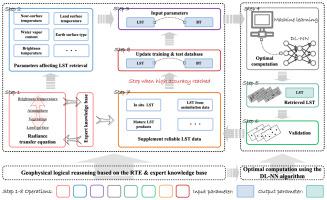Remote Sensing of Environment ( IF 11.1 ) Pub Date : 2021-08-26 , DOI: 10.1016/j.rse.2021.112665 Han Wang 1 , Kebiao Mao 1, 2 , Zijin Yuan 1 , Jiancheng Shi 3 , Mengmeng Cao 1 , Zhihao Qin 1 , Sibo Duan 1 , Bohui Tang 4

|
Most algorithms for land surface temperature (LST) retrieval depend on acquiring prior knowledge. To overcome this drawback, we propose a novel LST retrieval method based on model-data-knowledge-driven and deep learning, called the MDK-DL method. Based on the expert knowledge and radiation transfer model, we deduce LST retrieval mechanism and determine the best combination of the thermal infrared (TIR) bands of the sensor. Then, we use the radiation transfer model simulation and reliable satellite-ground data to establish a training and test database, and finally use the deep learning neural network for optimal computation. Three typical high-, medium- and low-spatial-resolution TIR remote sensing datasets (from Gaofen, the Moderate Resolution Imaging Spectroradiometer (MODIS), and Fengyun) are used for theoretical simulation and application analysis. The simulation shows that the minimum mean absolute error (MAE) is less than 0.1 K (standard deviation: 0.04 K; correlation coefficient: 1.000) at a small viewing direction (<7.5°) and less than 0.8 K at a large viewing direction (<65°). The in situ validation shows that the minimum MAE obtained by the optimal band combination is approximately 1 K (root mean square error (RMSE) = 1.12 K; coefficient of determination (R2) = 0.902). The retrieval accuracy is improved by increasing the number of TIR bands in the atmospheric window, and adding accurate atmospheric water vapor information produces better results. In general, four TIR bands in the atmospheric window bands are sufficient to retrieve the LST with high accuracy. Likewise, three TIR bands plus atmospheric water vapor information are sufficient for the retrieval requirements. All analyses indicate that our method is feasible and reliably accurate and can also be used to help design the instrument band to retrieve the LST with high precision.
中文翻译:

基于模型-数据-知识驱动和深度学习的地表温度反演方法
大多数地表温度 (LST) 检索算法都依赖于获取先验知识。为了克服这个缺点,我们提出了一种基于模型-数据-知识驱动和深度学习的新型 LST 检索方法,称为 MDK-DL 方法。基于专家知识和辐射传输模型,我们推导出LST反演机制并确定传感器的热红外(TIR)波段的最佳组合。然后,我们使用辐射传递模型模拟和可靠的星地数据建立训练和测试数据库,最后使用深度学习神经网络进行优化计算。三个典型的高、中、低空间分辨率TIR遥感数据集(来自高分,中分辨率成像光谱仪(MODIS),和风云)用于理论模拟和应用分析。仿真表明,最小平均绝对误差 (MAE) 在小观察方向 (<7.5°) 下小于 0.1 K(标准偏差:0.04 K;相关系数:1.000),在大观察方向上小于 0.8 K( <65°)。这原位验证表明,最佳波段组合获得的最小 MAE 约为 1 K(均方根误差 (RMSE) = 1.12 K;决定系数 (R 2 ) = 0.902)。通过增加大气窗口中TIR波段的数量来提高反演精度,添加准确的大气水汽信息会产生更好的效果。一般来说,大气窗口波段中的四个 TIR 波段足以高精度地检索 LST。同样,三个 TIR 波段加上大气水汽信息足以满足反演要求。所有分析表明,我们的方法可行且准确可靠,还可用于帮助设计仪器波段以高精度检索 LST。











































 京公网安备 11010802027423号
京公网安备 11010802027423号